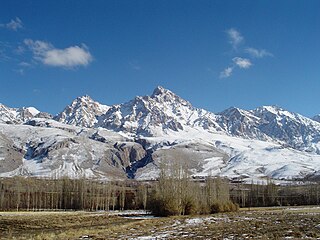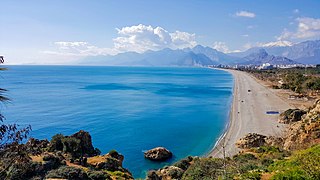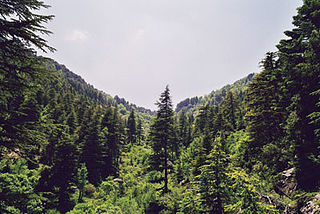
The Anti-Lebanon mountains are a southwest–northeast-trending, c. 150 kilometres long mountain range that forms most of the border between Syria and Lebanon. The border is largely defined along the crest of the range. Most of the range lies in Syria.

Cedrus libani, the cedar of Lebanon or Lebanese cedar, is a species of tree in the genus Cedrus, a part of the pine family, native to the mountains of the Eastern Mediterranean basin. It is a large evergreen conifer that has great religious and historical significance in the cultures of the Middle East, and is referenced many times in the literature of ancient civilisations. It is the national emblem of Lebanon and is widely used as an ornamental tree in parks and gardens.

The Taurus Mountains are a mountain complex in southern Turkey, separating the Mediterranean coastal region from the central Anatolian Plateau. The system extends along a curve from Lake Eğirdir in the west to the upper reaches of the Euphrates and Tigris rivers in the east. It is a part of the Alpide belt in Eurasia.

The Northern Anatolian conifer and deciduous forests is a temperate coniferous forests ecoregion located in northern Anatolia, Turkey.

The Eastern Mediterranean conifer-sclerophyllous-forests, also known as the Eastern Mediterranean conifer-forests, is an ecoregion in the eastern Mediterranean Basin. It covers portions of Turkey, Syria, Iraq, Lebanon, Israel, Palestinian territories, Jordan, and Saudi Arabia.

The Mediterranean Region is a geographical region of Turkey. The largest city in the region is Antalya. Other big cities are Adana, Mersin, Isparta, Antakya and Kahramanmaraş.

Abies cilicica, also known as Cilician fir or Taurus fir, is a species of conifer in the family Pinaceae. It is found in Lebanon, Syria, and Turkey. Abies cilicica and Cedrus libani, together with Acer hyrcanum subsp. tauricolum and Sorbus torminalis subsp. orientalis, are the predominant trees in the phytocoenosis Abeti-Cedrion, a type of forest of the middle and eastern Taurus Mountains of Turkey. These forests occur between 800 and 2,100 meters elevation. Over 5,000 years of logging, burning, and grazing have reduced these forests to enclaves.

Horsh Ehden is a nature reserve located in North Lebanon. It contains a forest of the cedar of Lebanon, making it a part of the country's cultural and natural heritage. Located on the northwestern slopes of Mount Lebanon with high precipitation, it hosts numerous rare and endemic plants. Stands of cedars also include a mixed forest of juniper, fir, and the country's last protected community of wild apple trees. In the forest are endangered eastern imperial eagles or Bonelli's eagles, gray wolves, wildcats, golden jackals, and red foxes. Valleys and gorges also have wild orchids, salamanders, mushrooms, and other flora and fauna.

The Italian sclerophyllous and deciduous forests ecoregion, part of the Mediterranean forests, woodlands, and scrub biome, is in Italy. The ecoregion covers most of the Italian Peninsula and includes both evergreen and deciduous forests.

The Dinaric Mountains mixed forests are a terrestrial ecoregion of the temperate broadleaf and mixed forests biome in Southeastern Europe, according to both the WWF and Digital Map of European Ecological Regions by the European Environment Agency. It also is in the Palearctic realm.

The Apennine deciduous montane forests are a temperate broadleaf and mixed forests ecoregion in the Apennine Mountains of Italy. The development of these forests is ensured by the high rainfall in the Apennines, combined with a temperate-cool climate. Because of climate change, the presence of silver fir, although still widespread, has been dramatically reduced in favour of beech.

The Central Anatolian deciduous forests, also known as the Central Anatolian woodlands and steppe, is a Palearctic ecoregion of the Temperate broadleaf and mixed forest biome. It is located in Central Anatolia, Asian Turkey.

The Eastern Anatolian deciduous forests ecoregion is located in the mountains of eastern Turkey. It is a Palearctic ecoregion in the temperate broadleaf and mixed forests biome.

The Anatolian conifer and deciduous mixed forests is an ecoregion located in southwestern Anatolia, Turkey. It has a Mediterranean climate, and is part of the Mediterranean forests, woodlands, and scrub biome.

The Carpathian montane conifer forests, also known as Carpathian montane forests, is a temperate coniferous forests ecoregion in the Carpathian Mountains of the Czech Republic, Poland, Slovakia, Romania, and Ukraine.

The Alps conifer and mixed forests is a temperate broadleaf and mixed forests ecoregion in central Europe. It extends along the Alps mountains through portions of France, Italy, Switzerland, Germany, Liechtenstein, Austria, and Slovenia. The ecoregion extends from the lower slopes of the Alps to its peaks, which include Mont Blanc, at 4,809 m (15,778 ft) the highest peak in the Alps.

The East Afghan montane conifer forests ecoregion covers a series of unconnected conifer forests along the border between Afghanistan and Pakistan, at elevations of 2,000 metres (6,600 ft) to 3,400 metres (11,200 ft) above sea level. The ecoregion supports the near-threatened Markhor (Capra falconeri chiltanensis), known as the Screw-horned goat, the national animal of Pakistan. The forests of the ecoregion have been heavily thinned for timber.


















